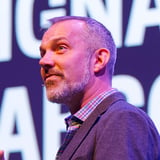Log in or create a free Rosenverse account to watch this video.
Log in Create free account100s of community videos are available to free members. Conference talks are generally available to Gold members.
Summary
The third in a series of discussions centered around Climate UX. To make an impact on the climate, many different audiences will need to understand and use climate science. But the science is complex and evolving rapidly. How might we best approach it as translators and facilitators? Through case studies and discussion you’ll learn how four designers are doing this today. Panelists: Ted Booth, HK Dunston, Andrew Otwell; Moderated by: Victor Lombardi
Key Insights
-
•
Climate Central converts slow, peer-reviewed attribution science into real-time, forecast-applicable data visualizations to better communicate climate causes.
-
•
Journalists and meteorologists prefer compelling, simplified visuals over deep scientific details due to time constraints, requiring UX to balance accuracy and usability.
-
•
Scientists demand literal, detailed data representations and are suspicious of metaphors or abstractions in UX design, valuing precision over simplification.
-
•
Designing for scientists involves embracing their existing mental models like Excel grids and visually 'clunky' graphs rather than innovating novel visualizations.
-
•
Ambient sensing uses secondary environmental signals, like sound and temperature fluctuations, to remotely monitor HVAC system performance without direct equipment attachment.
-
•
Creating new meaningful measures (e.g., degrees Fahrenheit per hour for HVAC efficiency) helps users understand complex scientific data intuitively.
-
•
Scientists prioritize minimizing false positives over false negatives, which influences the cautious language and presentation of climate science data.
-
•
Culture, storytelling, and design have a unique role in interpreting and responding to scientific data, especially where science alone can't convey urgency or meaning.
-
•
Learning scientific domains for UX requires humility, asking many questions, and gradually internalizing key vocabulary and concepts without deep expertise.
-
•
Designers can serve as cultural translators providing ‘cover’ for scientists to communicate findings within constraints of scientific rigor and funding pressures.
Notable Quotes
"The map is a model of the world. Models are simple versions of the world, so we lose accuracy but gain understanding."
"Scientists aren’t interested in analogy or metaphor because they can make them suspicious or seem like hiding something."
"Excel is the mental model of the scientific research world, a two dimensional grid that represents their literal understanding."
"We care about HVAC because we’re entering an era of energy scarcity we haven’t been in before."
"In science, it’s better to misidentify a phenomenon that exists than to say something’s happening when it isn’t."
"Designers are all about iteration and failure, but scientists face a very high cost of being wrong."
"The role of design is not just creating visuals but bringing a cultural perspective unique among the multidisciplinary team."
"Letting the data express itself simply is often better than fancy visualizations for real-world use and discovery."
"The long, careful analysis of observable phenomena is the value of science, and UX must support that process."
"You don’t need to understand all the science or math to do this work, just grasp foundational principles enough to support the goals."
Or choose a question:















More Videos

"The 1500 are designers, we don't distinguish strictly between UX or visual or industrial—they all bring design to the org."
Adam Cutler Karen Pascoe Ian Swinson Susan WorthmanDiscussion
June 8, 2016

"UX directors often feel like this poor person in the middle here getting pulled in all these directions."
Peter MerholzThe Trials and Tribulations of Directors of UX (Videoconference)
July 13, 2023

"If you haven’t designed who your teams are and who your players are, expecting people to comply with standards won’t work."
Lisa WelchmanCleaning Up Our Mess: Digital Governance for Designers
June 14, 2018

"The time for action is now, and it must be collaborative."
Vincent BrathwaiteOpener: Past, Present, and Future—Closing the Racial Divide in Design Teams
October 22, 2020

"Design your processes around learning, have blameless post mortems and celebrate failures especially."
Brenna FallonLearning Over Outcomes
October 24, 2019

"Working from home during the pandemic is hard because it’s fun only when you can actually leave your home."
Tricia WangSpatial Collapse: Designing for Emergent Culture
January 8, 2024

"Diverging and converging around the business model canvas helped us test and prototype delivery methods for the value propositions."
Edgar Anzaldua MorenoUsing Research to Determine Unique Value Proposition
March 11, 2021
"Knowledge needs to be thought of as a reusable circular process, not a linear one ending at project completion."
Designing Systems at Scale
November 7, 2018

"Randomization is magic — it evenly distributes confounds so the only difference affecting results is your change."
Erin WeigelGet Your Whole Team Testing to Design for Impact
July 24, 2024



















